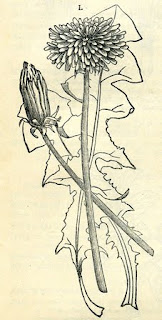
I emailed Muffy's mum, Mary (who lives in USA). I told her about the dandelion project and this is her reply:
Dear Rebecca
We have several kinds of dandelions here. The most prominent one is the common dandelion, taraxacum officinale, which was brought here by the early colonists from Europe. It was used for food, medicine and wine and was an important ingredient to their livelihood. Its popularity has waned through the centuries and is now an invasive plant, disliked by the majority.
I have always had an interest in dandelions and have studied every facet of their makeup and history. Healthwise, they contain vitamins and minerals galore! The leaves, blossoms, and roots are all edible, as well as medicinal. Each plant is a supermarket in itself. A few people still raise it for a vegetable and we have one town in Maine that has a canning factory that cans the leaves as greens, in the spring, when they are young and not bitter. A town in the state of New Jersey has a Dandelion Festival every spring. Farmers raise acres of dandelions and everyone gets into the spirit and helps with the preparations. Dandelions are prepared in every way you could imagine including deep fried blossoms, salads and lasagne!
The Russian dandelion, kok-saghyz, came to the United States during World War II. It has a much larger root with more latex. When the Japanese cut off our rubber supply, Russia sent us seeds of their dandelion so we could make our own rubber supply as they were doing. After the war, the plants were destroyed because it was not feasible when we could get back to our own rubber supply. That is another whole story that I have recorded for history.
Now I would like to hear about the printing side of the plant! I have rolled a brayer covered with paint over the underside of the leaves to get prints for teaching purposes, but that is my only experience in that direction!
I wonder if the invasive dandelion in Japan is the same as our common dandelion which came from England with the early settlers?
It was nice to hear from you.
Mary

No comments:
Post a Comment